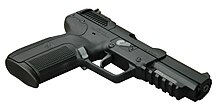Picatinny rail
The Picatinny rail ( English Picatinny rail ) is a toothed rail standardized according to NATO standards for the quick and repeatable mounting of accessories on firearms. Her, for example, can sighting devices , night vision devices , laser Papers , tactical light (engl. Taclight ), surface-mounted grenade launcher and - shotguns , cameras, Storm handles, Erdsporne , two- and three legs , handles and knobs, bayonets , cartridge holder, Taser or sleeve bags are fastened .
history
When SWAT and special units began to mount an increasing number of accessories such as light sources, red dot sights or grips on their weapons, it became necessary to standardize the assembly and increase the assembly options. In the 1980s, ARMS (Atlantic Research Marketing Systems) further developed the principles of the Weaver rail , the world's first standardized mounting rail, in order to meet these requirements. The Picatinny Arsenal later developed the system further with project manager Gary Houtsma and implemented the standardization.
On February 3, 1995, the specification was officially adopted. The Picatinny rail is officially designated as MIL-STD-1913 and with this specification was adopted in NATO as STANAG 2324 .
technology

Right picture: A Picatinny rail with a telescopic sight attached
The standard defines the shape and dimensions of the rail head and thus the actual mount for the accessories. The rail itself is 0.617 ″ (15.67 mm) and the rail head 0.835 ″ (21.20 mm) wide and these dimensions largely correspond to the Weaver rail.
The spaced rectangular transverse grooves are 0.208 inches (5.28 mm) wide and have a center-to-center spacing of 0.394 "(10.01 mm). The cross-section of the rail is roughly in the shape of a wide" T ", so that sighting devices and the like can be pushed up from one end and fastened. The transverse grooves on the one hand effectively absorb the recoil forces through the form-fitting connection and thus prevent the attached parts from migrating, and on the other hand allow assembly at different distances or more Devices one behind the other (for example the combination of a night vision device in front of the riflescope). The grooves are usually numbered to simplify assembly and to facilitate positioning of the accessories.

The underside of the rail is not standardized, but must be adapted to the contour of the weapon to which it is usually screwed. Typically, the Picatinny rail is mounted directly on the weapon housing, i.e. where there would otherwise be an open sight or a rifle scope .
Initially, mainly large-caliber rifles had a Picatinny rail; it was later used on assault rifles through the spread of night vision devices . Today it is also used to mount taclights, lasers , grenade launchers and other accessories, so that many modern weapons sometimes have several rails, including on the forend , such as the HK416 or the FN SCAR .
Protective strips made of plastic can be mounted on unused parts of the rail. These protected both the splint from damage and the hand from the edges of the splint and, at very low and high temperatures, cold and heat.
NATO rail


A further development approved in 2009 is the NATO rail (STANAG 4694), which can accommodate accessories developed for the Picatinny rail, but allows a more precise assembly, so that when changing optics you do not have to shoot it in again and again for a given weapon. The NATO rail is already used on the G28 .
Web links
- Specifications for Picatinny rails
- TECH TIP: Picatinny vs. Weaver Rail Specifications. In: bulletin.accurateshooter.com. February 28, 2009, accessed September 12, 2015 .
Individual evidence
- ^ Mounts and Ancillary Equipment. (PDF) (No longer available online.) May 18, 2006, archived from the original on September 24, 2015 ; accessed on September 17, 2014 (English).
- ↑ a b James Guthrie: Rail Crazy: Picatinny Rail Basics. In: Shooting Times. InterMedia Outdoors, November 23, 2010, accessed October 22, 2014 .
- ^ Dimensioning of Accessory Mounting Rail for Small Arms Weapons. (PDF) (No longer available online.) February 3, 1995, archived from the original on November 26, 2010 ; accessed on October 22, 2014 (English).
- ^ Per G. Arvidsson: NATO Infantry Weapons Standardization. (PDF, 650.76KB) NATO Weapons & Sensors Working Group, May 27, 2009, p. 12 , accessed on July 6, 2014 .
- ↑ a b Product description G28. Heckler & Koch, accessed July 6, 2014 .
- ^ Per G. Arvidsson: NATO Infantry Weapons Standardization. (PDF, 650.76KB) NATO Weapons & Sensors Working Group, May 27, 2009, p. 14 , accessed on July 6, 2014 .

